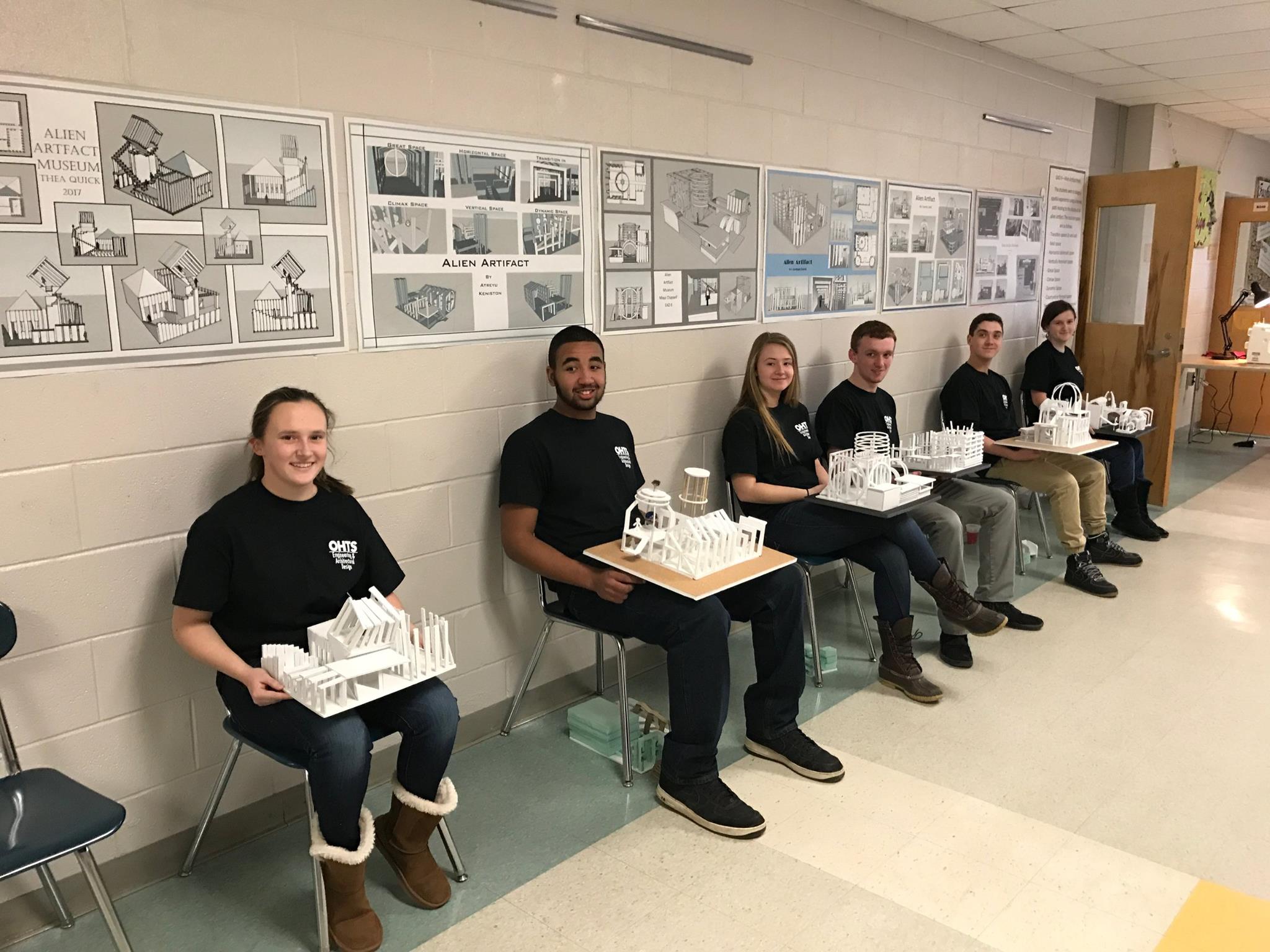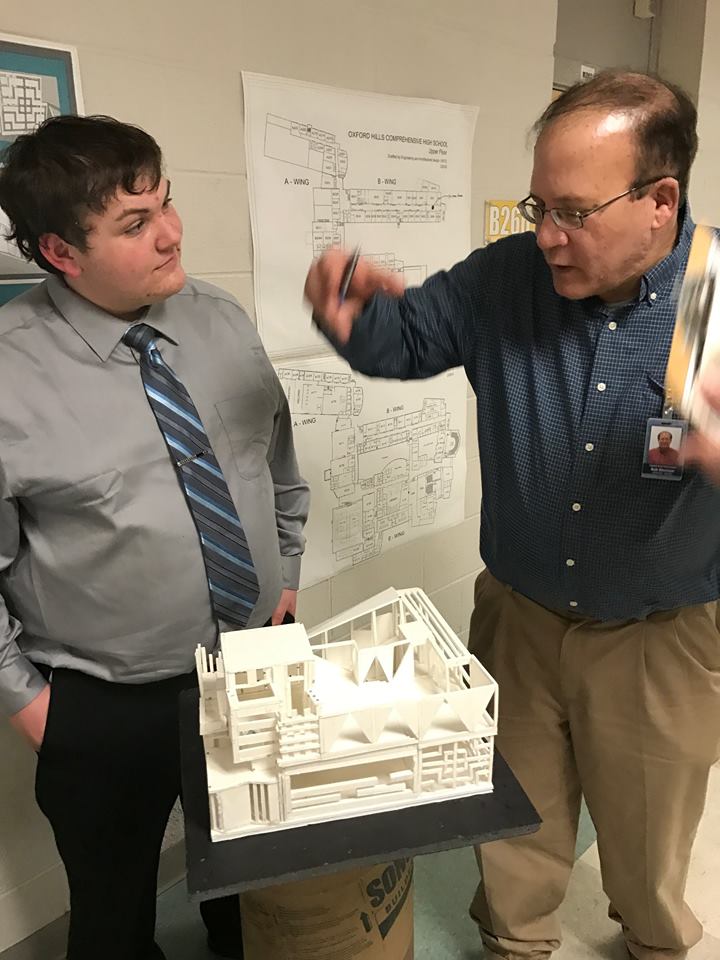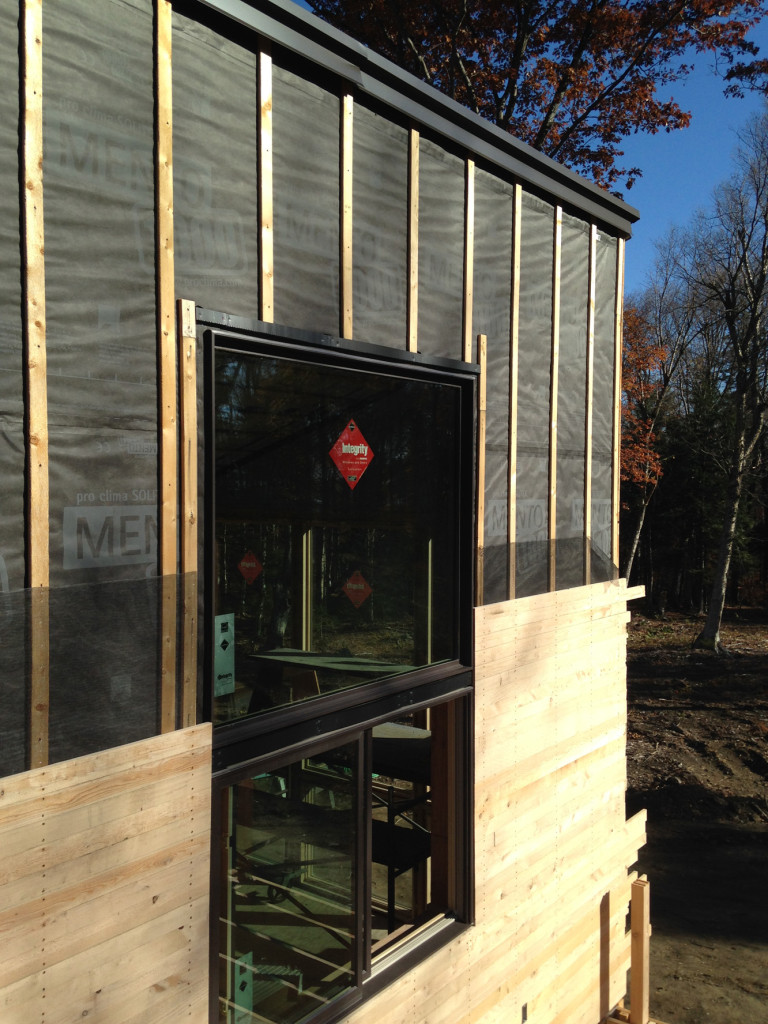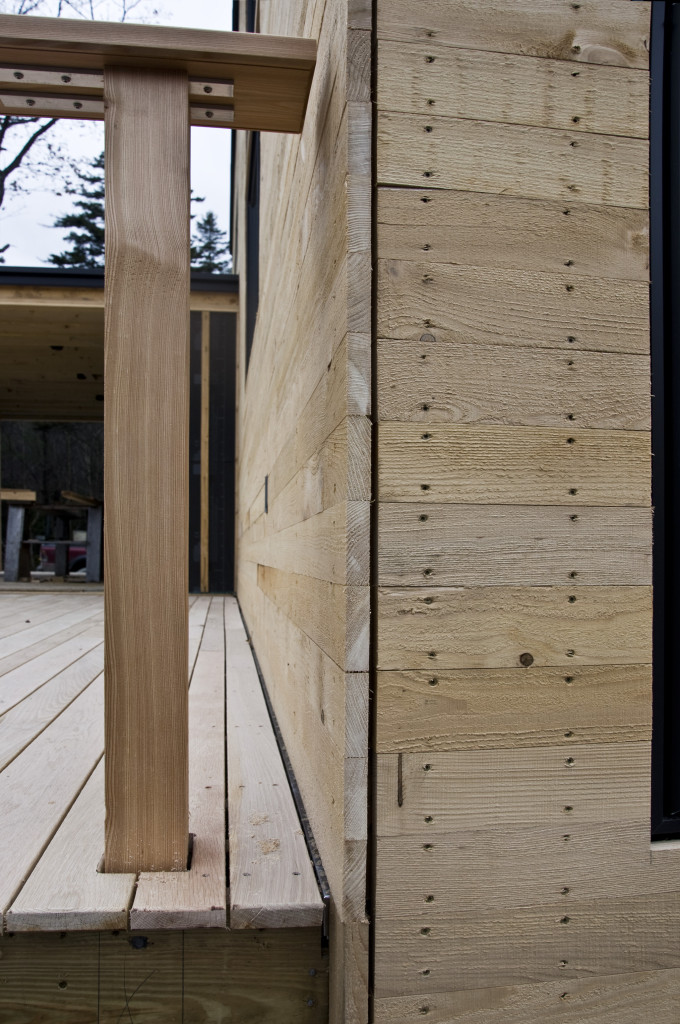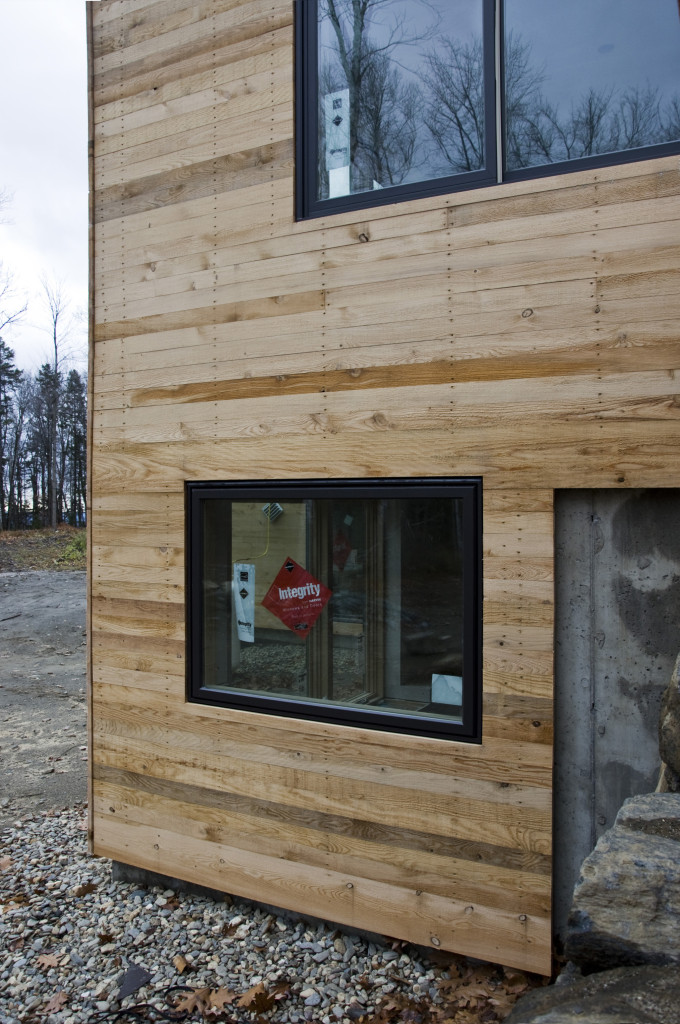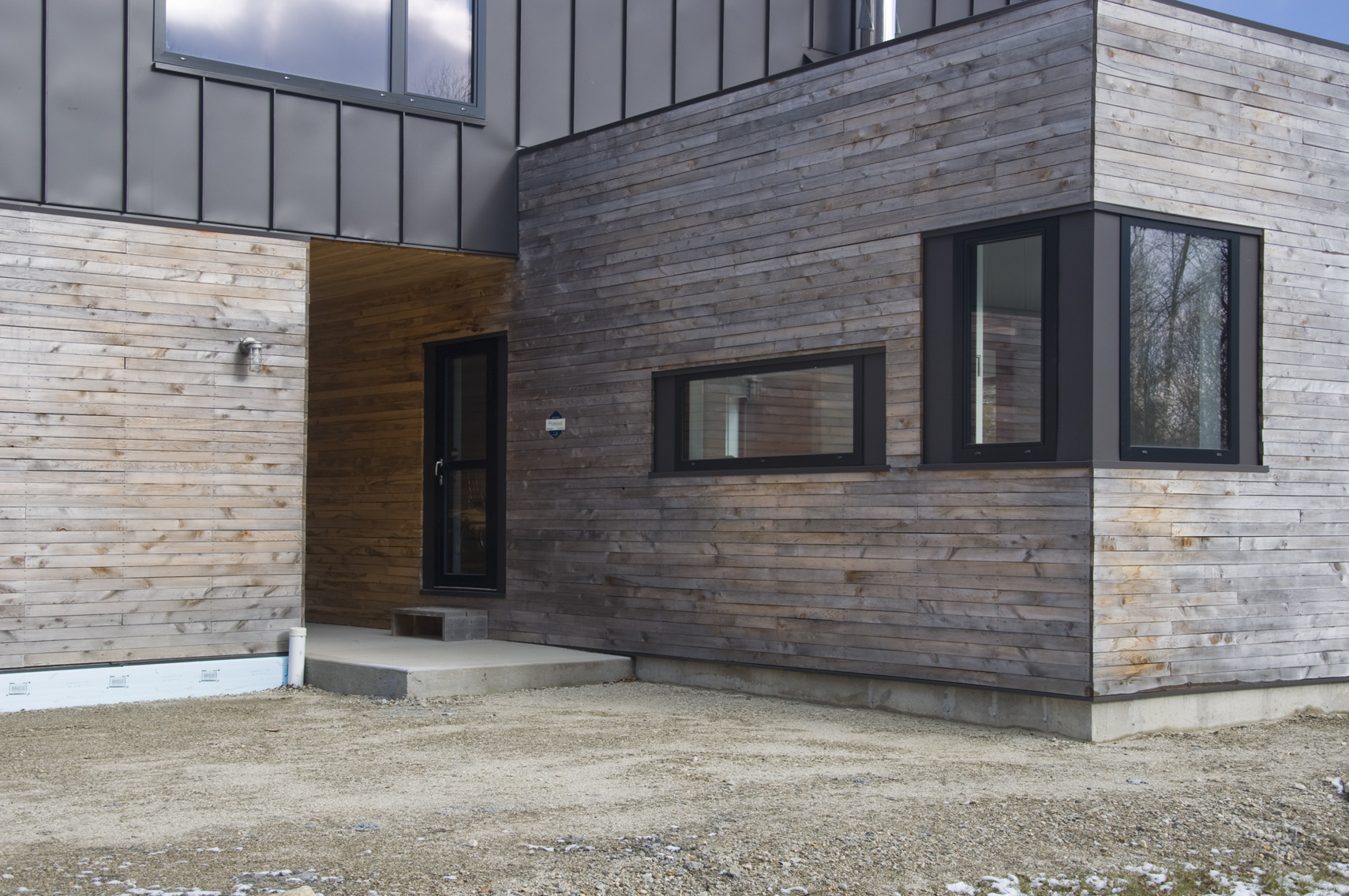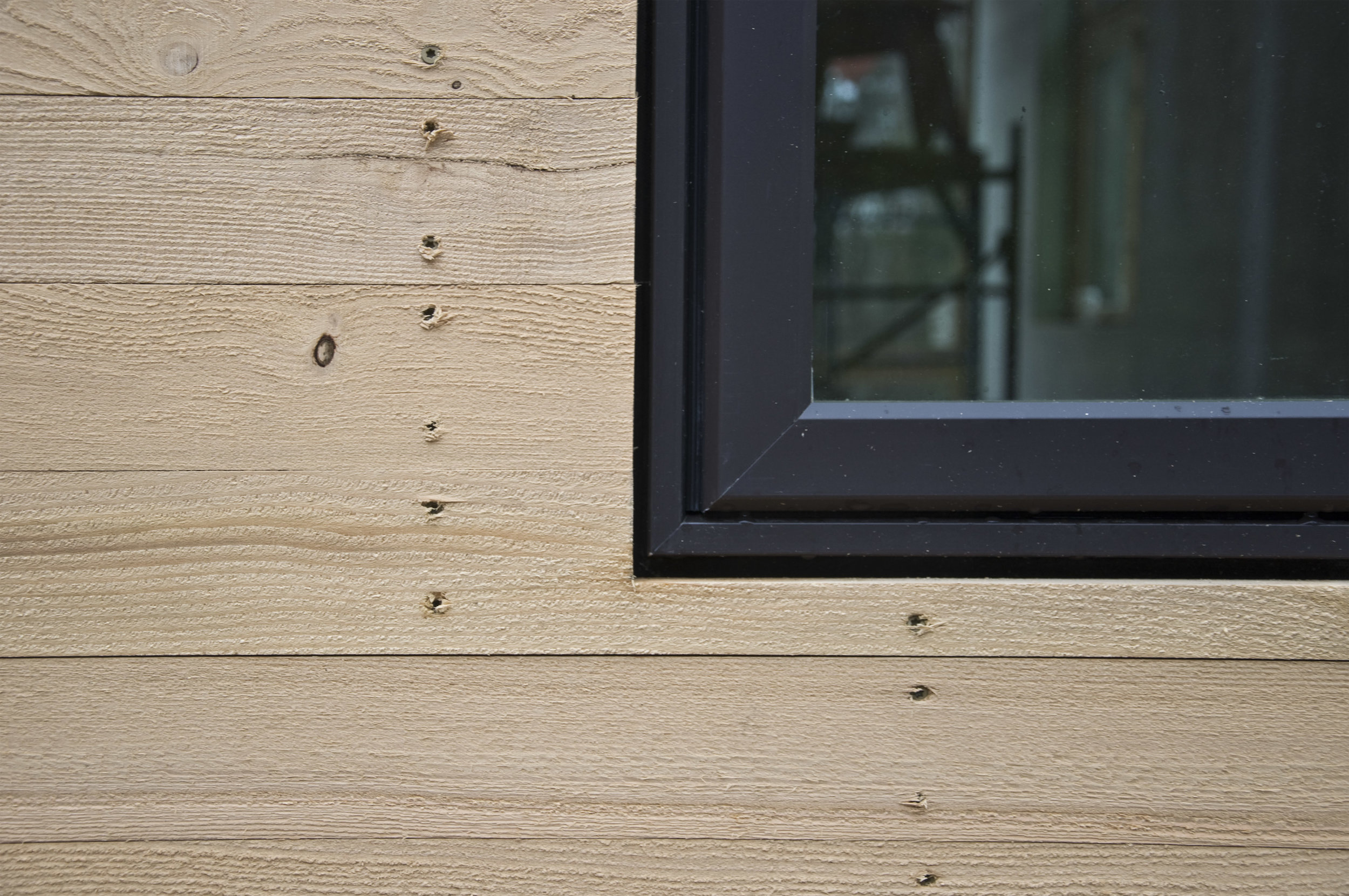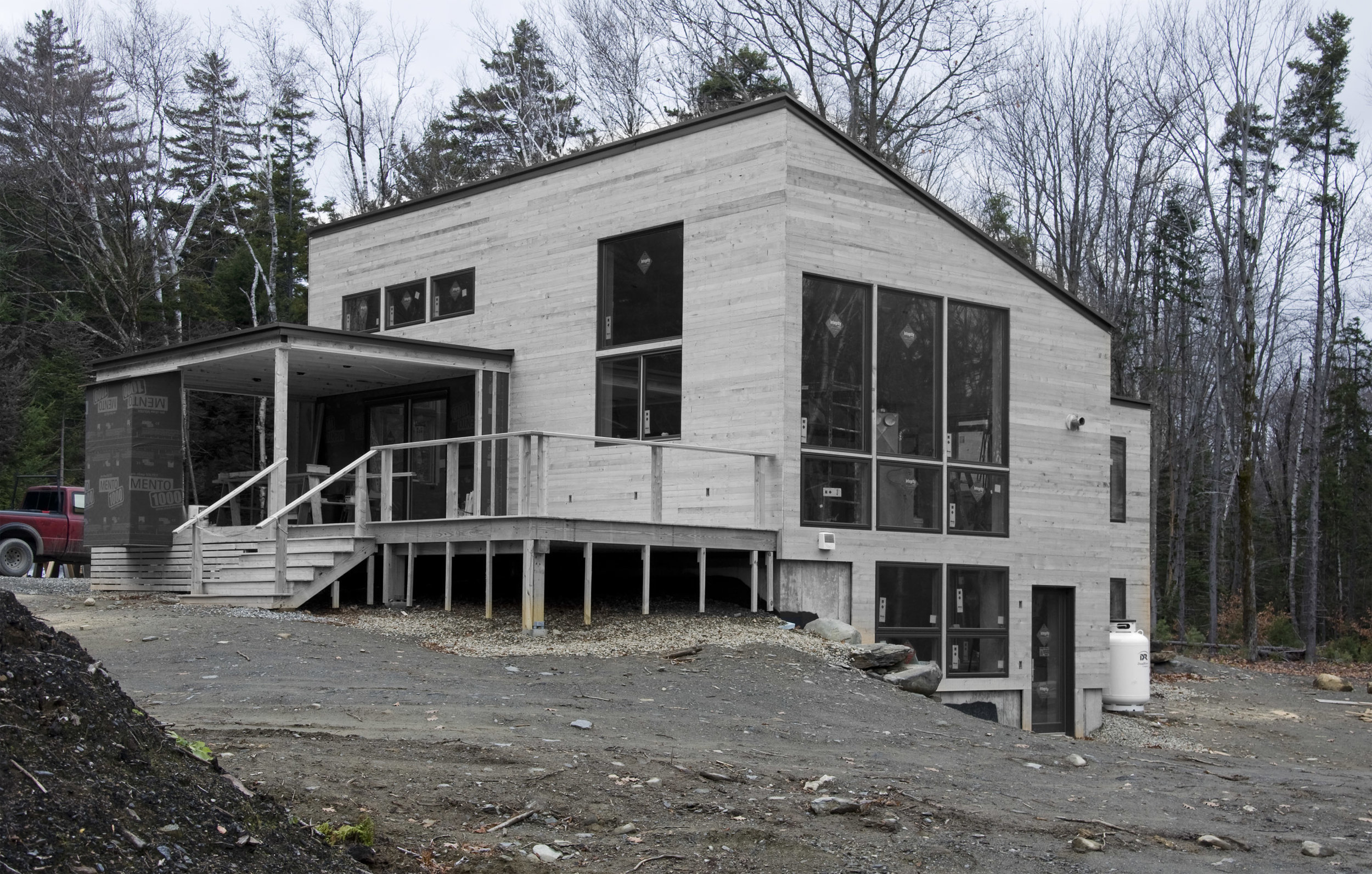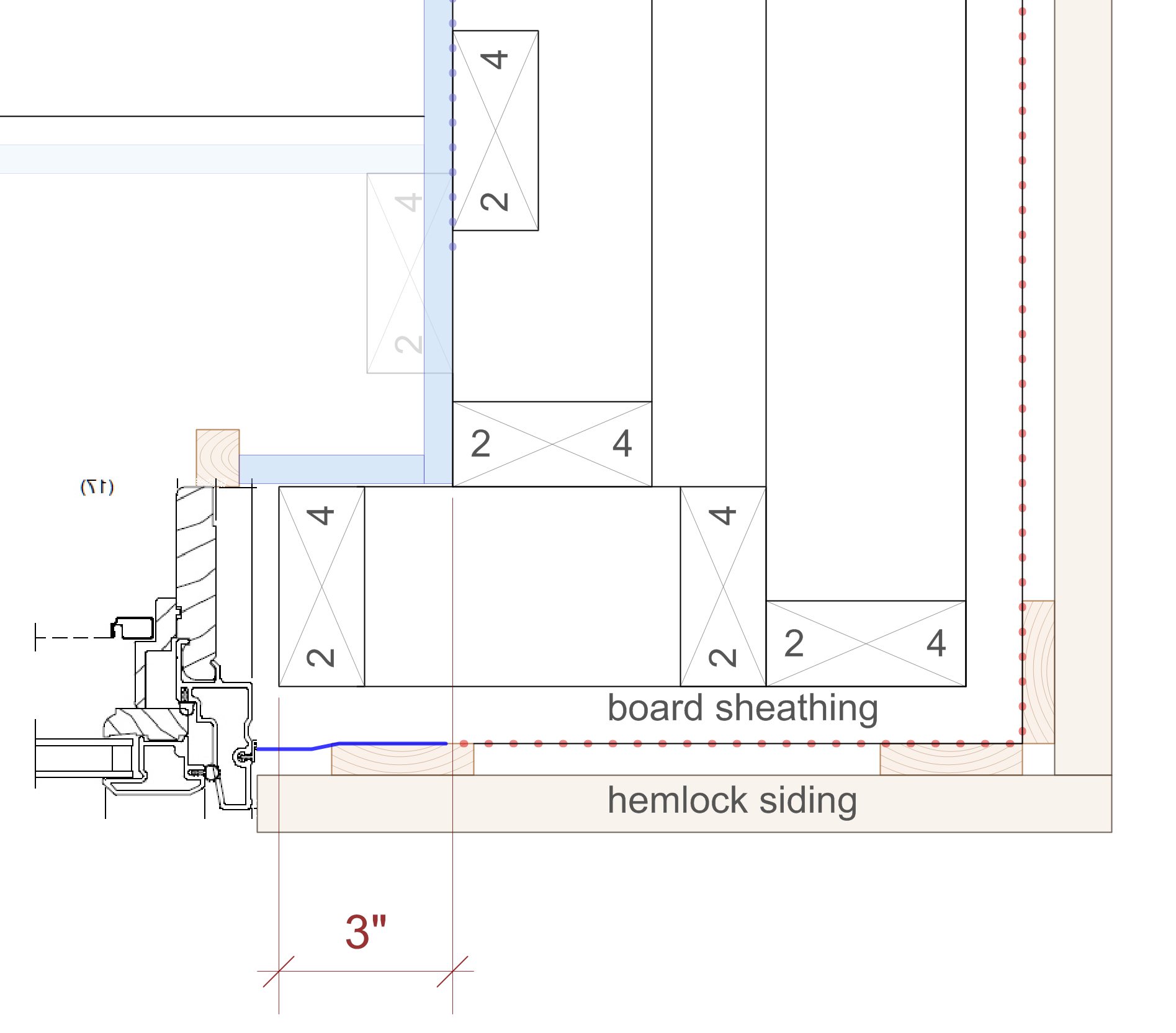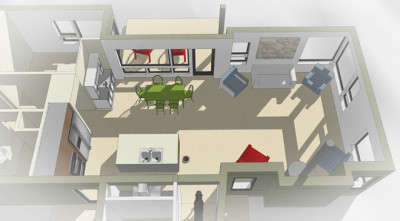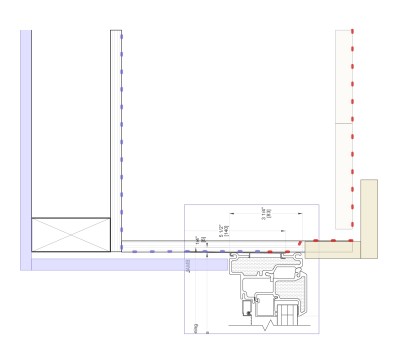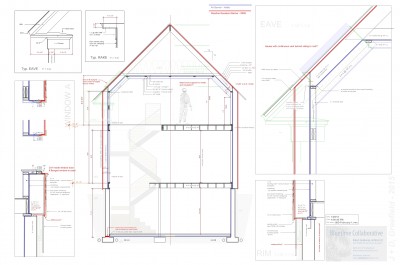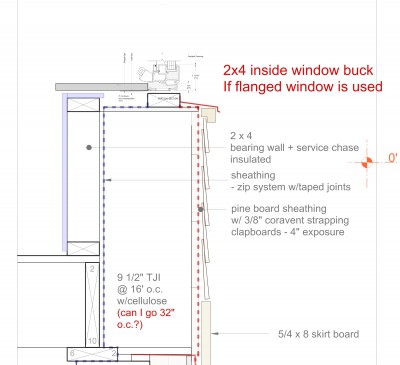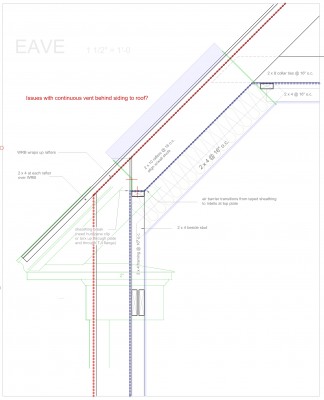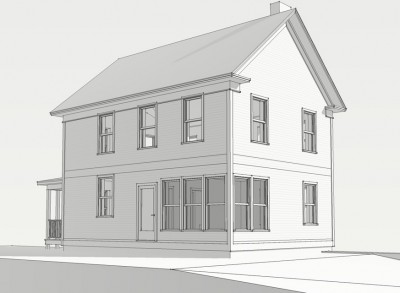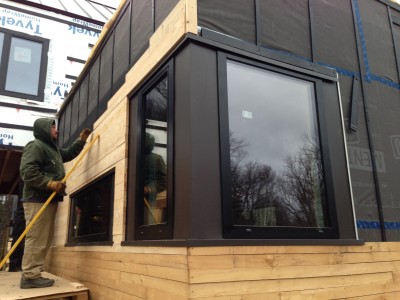Better Buildings conference 2019 - The path forward - file under musings
Process and Engagement - upping my game
The Engineering and Architecture program at my old high school
This past week I was invited back to my old high school in South Paris Maine to meet the students and be a judge for "Tech Night" in the Architecture and Engineering program. Daelynn Elizabeth is a high school classmate of mine who also became an architect. She has set up an amazing program to introduce the kids to architectural design. She uses teaching models from the early years of architecture school to introduce her students to 2d and 3d design. The students in the first class did two projects straight out of first year architecture school. The Cube project which I'm sure you architect readers all know and the small urban park. The students presented with models and a board with views and vignettes from a sketchup model. The second class had more of a path and place project and I was pleased to see students starting to bring their own layers of meaning to the program (poetry!)
The students in the third class did a project of their own choosing. One student did a house buried in a mountainside designed to allow for the survival of a holocaust which brought up more questions than answers (which is good) The second student designed a training facility in Portland Maine for the US Marines delayed entry program. This project was clean and trim and used a real site which has the potential of addressing the urban fabric. The third student presented a research project and design based on how to create a hurricane resistant house. She had a real location (In NJ in think) and had researched precedents. She also presented her project extremely well which was part of the judging criteria. She is headed off to architecture school next year where she will kick ***. In my opinion.
My critiquing skills were certainly a bit rusty but I managed and I hope I was constructive rather than mean. I got to hang out a bit with Dave Matero of David Matero Architecture who graduated from this high school as well but a year earlier then went to Roger Williams College and graduated 4 years ahead of me. (I got distracted) and Robert Sherman who does what Daelynn does at another school district. I was very impressed by the professionalism of all the students and especially by the respect and affection they had for their teacher.
A Better Way to Build
We are starting a new Bluetime Collaborative project here in the Brattleboro area. This will be a High Performance house that will provide the chosen team including myself and the builder the opportunity to refine the integrated process that goes with building a HPH. We don’t know yet if this project will be built toward any certification such as Passive House or Efficiency Vermont’s High Performance Home program. That question will be addressed early on in the design process. I reworked my contract quite a bit to set up and guide the process better than a standard contract does. This includes fleshing out the design process, what to expect and when, expected meetings along with the purpose and goals of those meetings and finally, guidance with selecting the right contractor for the job at the start of the project – meaning at the start of design.
I am fortunate to live and practice in an area with an impressively large number of excellent builders with a high level of interest and enthusiasm for building science and green building and training in Passive House and high performance building. I have been finding that I can’t or rather, shouldn't, as an architect, design and detail a HPH without the full partnership of the people who will be doing the actual building. I can’t draw up a set of plans and send them out to bid. There are many conversations to have during the design process with the builder and a high level of builder competency and knowledge is required.
The process of designing and building a High Performance Home requires a level of integration between architect and builder that is uncommon. In the past I have followed a more traditional approach, working with the client to develop a design then taking it to one or more builders to price and build. This is the normal way things are done and many builders and architects prefer this approach. I have decided however that to provide the level of service and quality of product that I want to be known for, a truly integrated and refined process where the builder is retained at the very beginning, provides expertise, guidance, cost-benefit analysis + research support from the very beginning of design is necessary. And I provide similar through construction.
The result can be much more time and resource efficient process, a more refined and well designed project, and overall, a higher level of control and accountability for the builder, the architect and most importantly, the client.
For this project, I introduced my clients to three such general contracting firms and helped them interview all three. The first meeting was with Josh and Gero of Mindel and Morse Builders – a firm that have worked a lot with. I was a carpenter with them in the late nineties after architecture school. The second meeting was almost immediately after that with Scott and Gabe of Mathes/Hulme. I had done the Brattleboro Tiny house with them several years ago when they were just getting started on their own and we have been looking for a project to do together ever since. Later in the day we met with Chad of Vermont Natural Homes (who built the Greenfield house) at his own straw bale home complete with an amazing spread of hors de vors (thanks Carly!) Wish I had gotten a pic of that.
All three firms are super-professional and very supportive of each other. There is an impressive culture of support among many local builders locally with a monthly building science group that supports continuing education and discussion. Firms often help each other out with manpower and expertise. This project can provide an excellent case study and learning opportunity for the local building community.
Over the next week, the clients were further wined and dined by the builders with house tours and the clients were starting to realize not only that they were in good hands but that they had a really difficult decision to make in choosing which builder to hire.
So now that I have put some serious pressure on myself (and the builder) to do an awesome job, I will reveal that the clients have chosen Mathes/Hulme who are now busy writing up a pre-construction agreement which will be a further definition of their role in the process that I introduced in my own proposal. I haven’t had a conversation with the clients yet about what tipped the scales toward Mathes Hulme. I tried to remain very neutral during the interviews which was rather easy as I was just pleased with the opportunity to work with any of the firms.
I will be meeting this week with Gabe Hulme and Mel Baiser of Helm Construction Solutions, a construction management firm that both Mathes/Hulme and Vermont Natural Homes use. We will discuss first steps, who will be doing what and when – process and scheduling. We will discuss how communications will be handled (we might give Slack a try) and generally mapping out the next few months. I have been sketching - schemes, sections, details etc to start that conversation with the builder before I refine it a bit and present to the client.
Stay Tuned!
Here is an article about High Performance Homes in ISSUES in Science and Technology
NESEA Pro tour - Hampshire College
Last month I toured the R.W. Kern center at Hampshire College with a bunch of Green building Geeks and fans as part of a NESEA pro tour. This building is being certified under the Living Building Challenge or LBC label. Pretty much the highest certification a building could achieve. Way beyond LEED. The architecture firm was Bruner Cott.
Side note: I met Simeon Bruner at Ashfield Stone without knowing who he was. (I don’t pay much attention to the goings on in my own industry) He told me his firm did Mass MOCA and I nearly fainted. Now Bruner/Cott is on my top list of firms that I follow and would like to work for. Except for the part where I rooted in Vermont and became a fuddy duddy.
The group also toured the Hitchcock Center architected by DesignLab architects and also built by Wright Builders. This building is also being built towards LBC certification. I can’t wait to see the finished product
NOVA NEXT ran an article about LBC and the Kern Center. The comments on the facebook are interesting and revealing. Education about green building is slower to trickle down than technology. We need gold standard buildings like this to learn from. Lessons learned go toward Hampshire college's goal of a net zero campus which then then are vetted and applied to the larger community. It also provides a learning tool for the current and next generation of thinkers who will apply those lessons elsewhere. Green building nowadays emphasizes durability and simplicity of systems in addition to energy use. This building will outlast most new buildings being constructed today and cost much less to own and operate. And attract the best and brightest students to the college. It's a win on so many fronts.
Here are a few photos I took during the tour plus a short video about the Hitchcock Environmental Center
New and Improved plan set structure
I'm trying out something new: a smaller scale simplified plan with all major reference information on the front cover so the contractor has one place to find all sections, details and locate windows and doors.

The floor plan gets broken into three 1/2" scale sheets later in the set. I learned that from looking at a set of very complete drawings from a big-time NY firm that a contractor friend was building from. 1/4" per foot drawings are more traditional but 1/2" scale (twice as big) is very relevant to modern high efficiency buildings where framing is much more relevant to windows and doors as well as being easier to understand air sealing details. There are also places where I need to show actual framing in plan.

I also try to get relevant section details on the same sheets as the overall sections where possible. I learned this from my days as a carpenter as well as through feedback from builders over the years.
Hemlock - Open Gap Rain Screen Siding
My use of eastern hemlock as a siding material has been generating interest. Hemlock is a common wood in Vermont but doesn’t get used a lot except in barns and outbuildings and sometimes for timber frames. My summer job during high school involved working in a small sawmill. We sometimes cut hemlock and I found the wood beautiful, but heavy. One summer, we cut some hemlock for a bridge. Fast forward um… lots of years and I ordered a bunch of hemlock for framing and decking when I built my barn. I learned a bit about how to work with hemlock, how it ages and weathers and I started thinking about how I could use it in my own work. I try to source materials as locally as possible and design within local builder's abilities and interests - which is easy to do here where builders get together monthly to discuss building science related issues

In rural New England, buildings are often sided with pine siding in a vertical shiplap form – and often unfinished. It tends to develop a black mold that is relatively harmless but can be ugly. I found that hemlock is more resistant to this mold. It’s also harder and more rot resistant. It is nowhere near as rot resistant as cedar, a more common siding material however.
White pine siding on my own barn

A brief on open rainscreen siding: Good architect and builders are installing siding with a vented airspace between the siding and weather resistant barrier (WRB). This allows any moisture that gets behind the siding to dry out before it does damage. Modern materials (a better WRB) and the venting detail allow us to use different materials and different details for the siding itself. I have commonly seen the open gapped rainscreen detail used with ipe boards but Ipe is a tropical hardwood related to mahogany. Cement based boards are also used commonly but cement has fairly high embodied energy. Both of these are not locally sourced materials. The gap in the siding also reveals a view of the WRB (depending on the size of the gap) This means that damaging UV rays are also reaching the WRB. And bugs. Thus the need for a better (and black) WRB. There are several on the market designed for this. Both projects shown here use Mento and tapes from Foursevenfive.com
It occurred to me that I could use narrow hemlock boards from local mills to create a very elegant (I hoped) rainscreen siding detail. It would use local and relatively inexpensive materials, it wouldn’t need paint or stain, installation could be simpler and faster if I got the details right, and if I installed it horizontally, the lowest courses could easily be replaced if the siding degraded due to splashback and snow banks. The damaged siding would not present a disposal concern – just toss it in the bushes and it becomes habitat for red backed salamanders. I was lucky to have a client with a taste for modernism allow me to try my ideas out on his home. The results were rather spectacular and gave me a sense of the potential. Now I am doing my second project with hemlock siding. The builders for this project (Webster Construction of Marlboro, Vermont) are quite familiar with good building science and modern products and methods. They saw the potential and were happy to give it a try plus they were able to improve my detailing in several ways which I can then incorporate into drawings and specifications for the next time around.
The hemlock turns silvery gray within a year. The narrow boards create a woven, fabric-like aesthetic.
The hemlock is installed "green" with deck screws. This siding is all 1x3 so gaps will be quite small as the wood dries. Fiberglass bugscreen is installed directly behind the siding. strapping can be regular 1x3 strapping although coravent makes an excellent product for this purpose and should at least be used on any strapping set horizontally such as over and under windows.
This is the corner trim detail the builder came up with and I really like. One side runs long and is cut after installation. The other side is held back for a crisp reveal - very architecty! Of note: the deck is white oak (local) and the post is European Larch which is from a harvest of a Vermont tree farm. European larch is used in Europe as a durable siding material that needs no treatment.
detailing around windows is super simple. On the first house I used metal panels (installed by the roofer) to accentuate the windows and wrap corners. Here it is about as simple as it gets.
Windows - decision making process
I am grappling with window issues for several projects right now. Designing, choosing, pricing and detailing windows is much more complicated than it was as recently as 5 years ago. I used to simply specify window sizes and the builder would have the lumber yard price a few lines or a favorite manufacturer. This is still the way it is done my most builders and architects. Now we have many more options to consider with windows and this has radically affected the decision making process. In the past we didn’t look carefully at the solar gain (how much warmth from the sun gets in, visible light transmittance, U value (insulation) and especially installation detailing. With my own work, a primary goal has become to eliminate the traditional heat distribution system – boiler (oil, propane or natural gas) manifold (that thicket of valves and pipes and pumps in the basement) and distribution (radiant tubes in the floor, baseboard radiators etc) – in favor of the simplicity of an air source heat pump and often, a wood stove for alternate or backup heating. The heating system then becomes a heating appliance. This has not, for my practice, been a client driven goal but I figure I’m not doing my job if I don’t discuss these options. Most clients in recent years have simply expressed a desire to minimize fossil fuel consumption and have a house that they don’t have to worry about leaving for a few weeks in the winter. Windows are usually the biggest variable in being able to minimize and simplify the heating equipment for a building.
The process, which continues to evolve, begins with sizing and placing windows according to light, views, privacy and ventilation. So far, a fairly traditional approach. Some things effect the decisions such as whether the window opens inward, outward, up and down, sideways, or not at all. Smaller windows open easier and larger fixed pane windows are cheaper (per square foot) so we often mix and match for maximum effect. Exterior doors are often now part of the window package as well.
I use sketchup modeling for this part of design as it brings a high level of clarity at an earlier stage than any method I’ve found thus far. This is also not so traditional.
Once we have arrived at a good window configuration we need to pin down some minimum energy performance specifications. The first big decision is double glazed vs triple glazed. Double glazed windows meet energy code currently but probably won’t in a few years. Window manufacturers (in the US – in Europe they are already there) are starting to realize this and gear up to offer triple glazed window options. A largish house with small windows can probably get away with double glazed windows and meet the energy use criteria I mentioned above. I also have found that with large areas of glass, comfort becomes a big issue. It can be very unpleasant to be near a large window at night when it is zero degrees outside. Condensation issues are vastly mitigated with a triple glazed window as well. I often do some energy modeling to get a sense of what the overall heat loads of the building are. It's easy to change around the U-value to see the effect of different windows. I'm also learning how to use the sketchup plugin for the Passive House Planning Package. In my spare time. (insert smiley emoticon)
Next we look at several different options from several different window manufacturers. Unplasticized PVC (UPVC) is usually the least expensive option for any window with aluminum and fiberglass usually more expensive but offering thinner profile frames. Wood is very expensive. I’ll stay away from the PVC argument here.
With preliminary pricing in hand we – myself, the builder and the client make THE DECISION and the subset of choices that affect the price and my detailing. When these decisions are made I can put specific CAD details from the manufacturer into my drawings and create much more accurate details for how it all the windows are installed, air sealing strategies, tolerances, finish work around the windows, very specific rough opening and flashing information etc. In the past this was all fairly standard and left to the builder to figure out in the field. We don’t do it that way anymore.
Always know what and where your AIR BARRIER is.
I’m working on detailing out a smallish house in Greenfield, MA. We probably won’t go full Passive House on this but we will look at what additional costs and detailing it would take. And if we’re close…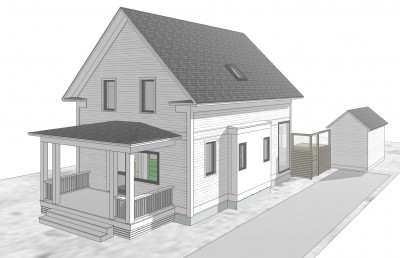 We are doing some novel (to me) stuff for the shell of the house that, I suspect, will become more standard practice for me in years to come.
Here are some “progress print” detail drawings from the plan set. My drawings tend to look a bit different than most architect's drawings due to two things: The time I spent wielding a hammer and trying to interpret my own drawings and the fact that I have worked as a sole practitioner for so long and have developed my own graphic style. I should add to that a third thing – my knowledge of building science informed best practices.
We are doing some novel (to me) stuff for the shell of the house that, I suspect, will become more standard practice for me in years to come.
Here are some “progress print” detail drawings from the plan set. My drawings tend to look a bit different than most architect's drawings due to two things: The time I spent wielding a hammer and trying to interpret my own drawings and the fact that I have worked as a sole practitioner for so long and have developed my own graphic style. I should add to that a third thing – my knowledge of building science informed best practices.
The first thing you will notice about these drawings is actually the most important thing. The red and blue dotted lines represent the weather resistant barrier and the air barrier respectively. If your drawings don’t have at least the air barrier called out in the sections, (and continuous around the thermal envelope) The drawings are incomplete. I have been getting picky in my detailing about how to make the air barrier both easy to achieve and durable. In my opinion, relying on painted sheetrock to serve as an air barrier just doesn’t cut it – certainly not for the next 100 years.
Many builders and architects in the Northeast US are still building 2x6 walls with fiberglass batts and a poly vapor barrier. That’s how I learned to do it when I was just starting out in the 90’s. I also opened up a number of walls built that way that were full of mold.
-
Good
builders don’t build this way anymore. Check the Building Science Corporation website for some pictures of what can go wrong.
One part of building science is probability and statistics. I often hear builders say “I’ve always built that way and I’ve never had any problems” - that you know about. But those builders are only looking at 50 or 100 projects. Luck plays a part here. What happens when you look at thousands or even tens of thousands? You start to see some patterns emerge and you start to see the luck factor drop out of the equation. You are able to formulate some best practice standards for a number of things including durability, air quality, energy use and even catastrophic failure. I prefer to work with builders who are informed about building science and involved in the discussion.
That’s easy here in the Southeastern Vermont area home of Building Green area, home of Building Green and SEON which sponsors a well-attended monthly building science discussion group and learning circle. – If anyone wants to get something like this started in their own community, send Guy an email at the address in their website.
I owe it to my clients to help them get the best constructed project possible. That, in addition to the most functional, aesthetically appropriate, finely crafted project possible.
– Oh and the budget thing too –
Detailing such as represented in these drawings is also very much about budget. The goal is to bump up the levels of insulation, air tightness, r value of windows etc. so that we can eliminate the traditional boiler and heat distribution system in favor of a minisplit heat pump which is more of an appliance than a system and dramatically less expensive. (I think this link is a GBA pro only link - subscription) For those without a subscription try this alternative Ideally, it becomes a wash cost wise but with the added bonus of very low monthly heating and cooling costs. Those savings alone can represent hundreds of dollars per month.
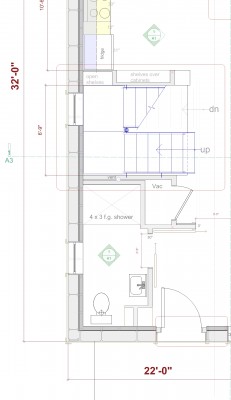
Thermal bridging and Air sealing - simplified
Just a quickie about thermal bridging and air sealing. I can explain it in way fewer words and terms and scientific-ness than what you find when you go looking for information on the web. Thermal bridging is when there is too much stuff that is not insulation in a section of exterior wall. This includes most traditionally framed houses. Especially near outside corners and around windows. In the cold of winter, the inside room surface of these areas stay much cooler than the surrounding room temperature and condensation occurs, then mold.
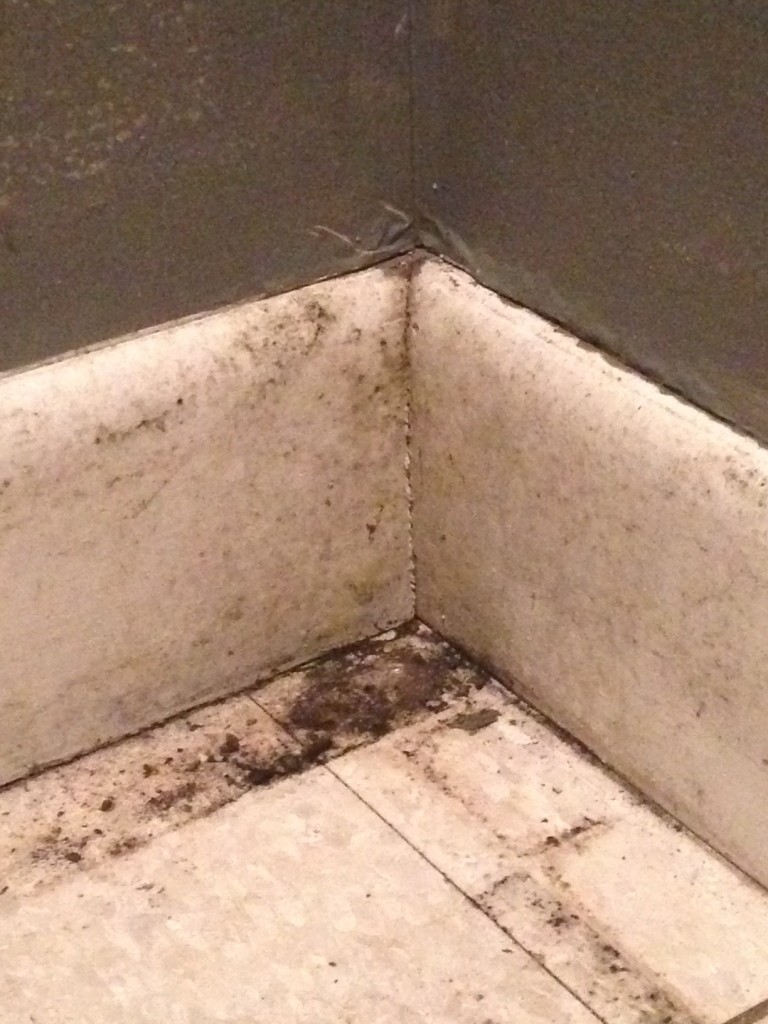
Improper air sealing is when your builder tells you your house needs to breathe and he's not talking about an air exchange system. Improper air sealing allows air to enter your house through tiny pathways through and near these moldy areas. The mold spores are then breathed in by your children.
Get it?
Passive House Training - One year later.
Note: this blog entry was published on Green Building Advisor on March 31, 2014 I have been asked about my Passive House consultant training by other architects enough times that I though I'd write up a quick synopsis, one year later.
For me, the Passive House training was very useful for several reasons, not the least of which was the networking aspect. It is a small community with some really great conversation happening and it is fun to be a part of that. There is a lot of controversy as well, especially on GreenBuildingAdvisor.com Such as where does the law of diminishing returns kick in when it comes to insulating and how to handle latent loads (excess moisture). Plus there's the whole U.S. vs the rest of the world thing which I won't go into as I find it rather annoying, or at least boring. Secondly, It represents state of the art science on how to build good buildings with an overriding emphasis on simplicity and quality. Passive House is really all about quality and even, as I'm finding out, represents a necessary re-thinking of how to get something built. A much more collaborative approach is necessary than often happens when building even high-end projects. The process gets much less linear. I also like the idea that the Passive House approach is a valid part of the conversation, not just achieving certification and getting the plaque to hang beside the front door. I see projects being showcased that utilized the approach in a value engineering manner to get the most bang for the buck that simply don't have the budget to go all the way and attain certification and I like the general consensus that that is okay. Much of my own work had been trending in the PH direction anyway so it was good to undergo the intensive training so that I could make decisions with much more confidence and authority that comes with PH credentials. As an architect who was never very (ahem) enthusiastic about the numbers and physics of things and more into the airy-fairy poetic nature and scholarly aspect of architecture it was also helpful in terms of training my weaknesses. I call myself a Passive House designer rather than a consultant in part because If I were to attempt a full-on certified Passive House, I would want to hire someone more experienced who does this on a daily basis to do the actual numbers part and look over their shoulder through the process - at least for the first few times. There is also the notion, similar to my approach to structural engineering where I try not to design anything too complicated to engineer myself - I prefer not to design anything that would require a complicated heating/ventilating system. It does get more complicated in renovation/addition work though for sure. My approach to structural engineering has always been very intuitive and very related to my own building experience and knowledge of materials, assemblies and connections My structural engineering professor once told me that the intuition part is vital and more than half the battle. First you intuit the solution then you apply numbers and formulas to check yourself. The Passive House training augmented my intuition and gave me more confidence to apply the numbers as well as a perspective on when, where and why.
Plus it was really good for marketing.
If you want your house to breathe, give it a set of lungs.
I had another comment recently from a builder who wants to build a house that breathes. I started to reply in an email and then decided to put it hereon the blog instead. What we are doing nowadays in the world of high performance homes is based on studying hundreds of thousands of houses built in the last half century that have failed (which includes the majority of 70's and 80's super-insulated and passive solar homes in the northeast) and applying those lessons to building a durable house nowadays. Houses from before that time period that failed for one reason or another are mostly gone and many of those that remain are simple piggy banks for big oil. We put our money in and the oil companies take it out. Simple. (usually, I like simple but...) For the past few decades, builders in the northeast have been living in a vacuum while the northern Europeans and Canadians paid much more attention to how houses fail, learning from them and adapting. Now the conversation is opening up again and we are taking a seat at the table.
I have lived in houses that breath my whole life. It sucks. Aside from the part where you have to give your money to someone else just to not freeze to death in the winter, there is the comfort aspect of things. Houses I have lived in have never been all that comfortable whether in terms of temperature or moisture levels or even wiping mildew off the window sills. Now, with two children, I worry about the air quality and mold issues inherent in my house that breathes. I would rather be able to seal up the house in the winter and be confident that I was breathing fresh Vermont air all the time than have to step outside for a breath of fresh air or open up the doors and windows if I screw up on getting the woodstove going. Six months out of the year, I would still have the choice to open the windows and turn off the HRV.
We do seem to have more summer moisture and humidity problems than we used to but we also have access to more durable and proven materials and building methods. Some builders and architects are taking advantage of this but most are building the same way they did 20 years ago despite all the failures. A house that breathes and has little or no insulation is a barn and If you want to heat it, that means coming to terms with giving your money away. Jesse Thompson says "People breath air through their lungs, not their skin. Why should houses be any different?" If you want your house to breathe, give it a set of lungs.
There are a range of options for doing this from exhaust only bathroom fans and range hoods (simple and cheap but where does the makeup air come from in a very tight house?) to a full-on Heat Recovery Ventilation System or HRV. These are also fairly simple and effective although significantly more expensive but have the added advantages of recovering much of the heat from the outgoing air as well as providing fresh incoming air exactly where you want it. For more information just type "HRV" or "house ventilation" into the search box on Green Building Advisor and start reading.
Window installation in a super-insulated wall
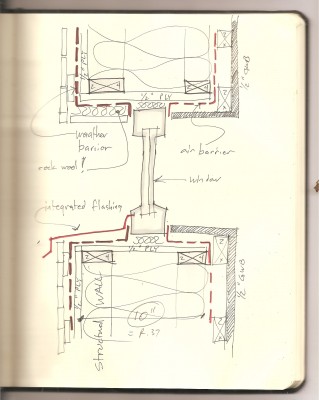 Designing a Super-insulated wall with good drying potential and good air sealing is easy. But the Devil is in the windows. With passive house level construction we want the window to be recessed toward the middle of the opening and the middle of the adjacent insulation layer. This is about thermal bridging and heat loss. An advantage that I've found is that it can potentially simplify the flashing which is certainly a welcome idea. Window and door installation has become increasingly complex over the past decade especially with exterior foam details. (I try to stay away from that) What I'm looking at in this sketch is how flashing for siding can be decoupled from flashing for the window to a great extent. Does the siding even need flashing anymore? Depends on how you do the siding. With some Rain screen siding details, perhaps not! Windows are now coming with really nice integrated sill flashing - you specify the depth when you order. This makes for a much more integrated and seamless system which should have long term durability advantages over what we have been doing up until now. What is missing from this drawing is an exterior layer of rock wool insulation to keep the sheathing warm (not rigid foam !) A more expensive detail and this may be less important when using cellulose than fiberglass insulation but is a detail I would certainly do on my own home. The other option is to use more of a Larsen truss system similar to what Chris Corson is doing in Maine with no exterior sheathing. It is A tough sell around here to leave the insulation protected only by a weather barrier such as Mento plus. The conversation on building science is terribly interesting and seems to be resolving itself towards simplicity as we gain knowledge and experience about what works and what doesn't and develop products and materials based on our increasing knowledge base. Of course, 93% of builders and architects aren't really paying much attention.
Designing a Super-insulated wall with good drying potential and good air sealing is easy. But the Devil is in the windows. With passive house level construction we want the window to be recessed toward the middle of the opening and the middle of the adjacent insulation layer. This is about thermal bridging and heat loss. An advantage that I've found is that it can potentially simplify the flashing which is certainly a welcome idea. Window and door installation has become increasingly complex over the past decade especially with exterior foam details. (I try to stay away from that) What I'm looking at in this sketch is how flashing for siding can be decoupled from flashing for the window to a great extent. Does the siding even need flashing anymore? Depends on how you do the siding. With some Rain screen siding details, perhaps not! Windows are now coming with really nice integrated sill flashing - you specify the depth when you order. This makes for a much more integrated and seamless system which should have long term durability advantages over what we have been doing up until now. What is missing from this drawing is an exterior layer of rock wool insulation to keep the sheathing warm (not rigid foam !) A more expensive detail and this may be less important when using cellulose than fiberglass insulation but is a detail I would certainly do on my own home. The other option is to use more of a Larsen truss system similar to what Chris Corson is doing in Maine with no exterior sheathing. It is A tough sell around here to leave the insulation protected only by a weather barrier such as Mento plus. The conversation on building science is terribly interesting and seems to be resolving itself towards simplicity as we gain knowledge and experience about what works and what doesn't and develop products and materials based on our increasing knowledge base. Of course, 93% of builders and architects aren't really paying much attention.
I am a Passive House Designer!
Apparently, although I never got an email, I am now a Certified Passive House Designer!!

What is Passive House ?
- The passive house standard represents the highest level of energy efficiency and “green building”. - The passive house standard is where state and municipality energy codes are headed. - Public housing groups such as Habitat for Humanity and regional housing authorities and land trusts are starting to require new housing units to be built to the passive house standard as these groups tend to prioritize overall cost of ownership over initial cost of construction. - The roots of Passive House trace back to the 1970s, when the concepts of superinsulation and passive solar management techniques were developed in the United States and Canada. - More than 25,000 buildings have been built to the Passive House standard in Europe. The standard is especially common in multi-family housing where it often makes little financial sense not to build to this level of energy efficiency.
Concept “Maximize your gains, minimize your losses”. These are the basic tenets of the Passive House approach. A Passive House project maximizes the energy efficiency of the basic building components inherent in all buildings; roof, walls, windows, floors and the utility systems: electrical, plumbing & mechanical. By minimizing a building's energy losses, the mechanical system is not called to replenish the losses nearly as frequently. This saves resources, operational costs and global warming related pollution. Unlike any other structures, Passive House buildings maintain occupant comfort for more hours of the year without the need for mechanical temperature conditioning of the indoor air. The opposite has been the norm in this country where we have a history of inexpensive fuel and construction techniques with little consideration for energy losses through thermal bridging, air-infiltration, and inadequate levels of insulation.
Passive House is both a building energy performance standard and a set of design and construction principles used to achieve that standard. The Passive House standard is the most stringent building energy standard in the world The Passive House approach focuses on the following:
Strategic Design and Planning: Passive House projects are carefully modeled and evaluated for efficiency at the design stage. Certified Passive House Consultants are trained to use the Passive House Planning Package (PHPP), a tool that allows designers to test “what-if” scenarios before construction begins. They are also trained to use other software tools to identify and address potential thermal bridges and moisture issues at the design stage. Specific Climate, Siting and Sizing: Passive House design uses detailed, specific annual weather data in modeling a structure’s performance. Orientation of the windows can maximize or minimize solar gain and shading. Passive House theory leans towards minimizing the surface area to interior volume ratio, favoring an efficient shape to minimize energy losses. Super-Insulated, Air-Tight Envelope (But Diffusion Open): To keep the heating/cooling in, wall assemblies require greater insulation values to “stop the conditioned air” from leaving. Walls are typically much thicker than today’s standard construction. Passive House takes great care in designing, constructing and testing the envelope for an industry-leading control of air leakage. Blower door testing is a mandatory technique in assuring high performance. Walls are designed to be virtually air tight, while allowing water vapor to dry out. “If moisture gets into the wall, how does it dry out before damage can occur?” is a fundamental tenet of modern building science addressed in Passive House design. Wall assemblies are analyzed to allow for proper water and moisture management to make a long lasting and an exceptionally healthy building. Thermal Bridge-Free Detailing: Breaks in the insulation layer usually caused by structural elements and utility penetrations in the building envelope create a “thermal bridge,” allowing undesirable exterior temperatures to migrate to and “un-do” expensive interior conditioned air and creating colder interior surfaces that encourage the growth of mold. Passive House design attempts to minimize thermal bridges via progressive mindful architectural detailing. Advanced Windows and Doors: Historically these items are the weak link of a building’s envelope and thermal defense system. Passive House places significant emphasis on specifying high performance windows and doors to address concern. To meet the high performance needs of various climate zones, windows must meet strict performance standards regarding: component insulation, air tightness, installation and solar heat gain values. Energy Recovery Ventilation: The “lungs” of a Passive House come from a heat (or energy) recovery ventilator (HRV/ERV). It provides a constant supply of tempered, filtered fresh air 24/7 and saves money by recycling the indoor energy that is typically found in exhaust air. The heat from outgoing stale air is transferred to the unconditioned incoming fresh air, while it is being filtered. It provides a huge upgrade in indoor air quality and consistent comfort, especially for people sensitive to material off-gassing, allergies and other air-borne irritants. HRV's are fast becoming standard equipment in all new houses in Vermont. Heating: One of the best benefits to implementing Passive House design is the high performance shell and extremely low annual energy demand. This allows owners to save on operational costs as they can now significantly downsize a building’s mechanical system. Passive solar gains, plus heat from occupants and appliances supply most of the needed heat. Radiant floor, baseboard, or forced hot air heating systems are unnecessary! Alternative Energy: Considering alternative energy systems on your project? Building to meet the Passive House Standard is the smartest starting point. The significant reduction in energy use, allows alternative energy to power a greater percentage of a buildings demands. Likewise smaller demand equates to smaller and more affordable alternative energy systems providing higher cost-benefit value. Passive House design puts a project within reach for achieving true “Net Zero” performance (the building generates as much energy as it consumes over the course of a year), making use of alternative energy systems smaller thus more affordable and attainable.
More Passive House Stuff
From Passive House Academy - I like the use of wine. It takes only two bottles of wine for a family of four.... or something like that. Just watch the video.
SEON - building science learning group in Brattleboro
 SEON or Sustainable Energy Outreach Network is a relatively new organization in the Brattleboro area. The mission from the website is to “establish a network that promotes Southeastern Vermont and its neighboring regions as a vibrant center of sustainable energy.” which sounds rather vague. I think they are trying to feel out exactly what their role in the community will be. They are off to a great start by sponsoring a monthly building science learning group. This is in a presentation and discussion format, often moderated by Peter Yost of EBN and GBA, with topics brought to the group by the participants who are mostly local builders.
SEON or Sustainable Energy Outreach Network is a relatively new organization in the Brattleboro area. The mission from the website is to “establish a network that promotes Southeastern Vermont and its neighboring regions as a vibrant center of sustainable energy.” which sounds rather vague. I think they are trying to feel out exactly what their role in the community will be. They are off to a great start by sponsoring a monthly building science learning group. This is in a presentation and discussion format, often moderated by Peter Yost of EBN and GBA, with topics brought to the group by the participants who are mostly local builders.
“Each month over 20 building professionals meet for 3 hours to advance their understanding of building science principles especially as it pertains to the problems they confront on their worksite. Case studies are reviewed, root cause analysis is applied, hypotheses are generated based on the physics of building science. The challenge is that there are no clear solutions to many of the problems. We are still learning in the midst of uncertainty and ever changing product design. Hence the need for ongoing discussions.”
The discussions are at a pretty high level but are very accessible to everyone as a goal is to bring the general building science knowledge level in this area to a very high level, making this area even more of a hotbed for green building than it is currently. Many of these folks are way beyond the standard hour and a half presentation you tend to get in symposiums such as at Better Buildings up in Burlington – not to knock that one (definitely go!) - and, perhaps had been feeling the need for much more in-depth and collaborative discussion relevant to their own daily work.
As an architect, this is a joy to see because these are the folks that I get to work with on a regular basis. As an architect, I often have to provide a basic education in building science to both the builder and the client. Having a builder who is “hip” to green building and building science issues makes my job much easier.
I encourage any local builders, architects and designers, and any folks involved with building and energy to check this group out. They usually meet from 3 to 6, once a month on a Wednesday or Thursday. Where and when can be found on the website calendar.
Passive House Training with Passive House Academy
 I have competed the Passive House consultant/designer training and am almost ready to take the exam on Friday of this week. (eek!) Training consisted of 2 three-day sessions in Boston with instructors from Passive House Academy. There were 8 other people in my class including 5 architects, two people from European window companies and a person from an air exchanger company and I have to say that despite the difficulty and intensity of the material covered, we had fun. The instructors were Irish so, in the same way that I slip back into a Maine accent when I am talking to someone from Maine, I found myself speaking and even thinking with that lovely Irish flow. That lasted about a day and was somewhat annoying.
I have competed the Passive House consultant/designer training and am almost ready to take the exam on Friday of this week. (eek!) Training consisted of 2 three-day sessions in Boston with instructors from Passive House Academy. There were 8 other people in my class including 5 architects, two people from European window companies and a person from an air exchanger company and I have to say that despite the difficulty and intensity of the material covered, we had fun. The instructors were Irish so, in the same way that I slip back into a Maine accent when I am talking to someone from Maine, I found myself speaking and even thinking with that lovely Irish flow. That lasted about a day and was somewhat annoying.
The course and the training is relatively new and evolving. The content of the course is all about creating super low energy use buildings using highly vetted building science. The concept is based on these 5 fundamental principles:
-Very high levels of insulation -Avoiding thermal bridges -Using high performance (and very nice and very expensive) windows and doors -Airtight construction (lots of detailing and testing to insure air-tightness) -Controlled mechanical ventilation with heat-recovery
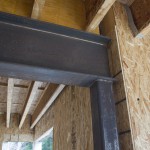 Example of Structural Steel with no thermal bridging
Example of Structural Steel with no thermal bridging
This is all familiar stuff to any builder or architect who is paying attention these days but Passive house goes beyond the current codes to where codes will be in 10 to 20 years. This is passive solar design from the 70's brought to the highest levels. It is no longer experimental but based on sound physics, a huge data base of existing projects, an understanding of moisture and air quality issues. It is also very much based on simplification. We have a huge understanding of how buildings work and how they fail so Passive House is all about using that knowledge to create buildings that succeed. For a great primer on Building science check out the Summer 2012 issue of Fine Homebuilding which you may still be able to pick up on newstands. There is an article by Kevin Ireton entitled “The Trouble With Building Science.
The economics of building to the Passive House standard are very persuasive. So persuasive that housing groups around this country including Habitat for Humanity and public housing developers are taking notice. They already took notice in Europe of course and are building many housing projects to using Passive House principles. Schools are a particularly important application of Passive House design because of air quality in particular. When you add long term operating and maintenance costs, energy costs, decreased liability issues etc. to the initial building costs, it is hard to imagine building any other way. In Europe the banks are taking notice of this as well in terms of favorable lending rates.
A big selling point is air quality and the durability of buildings. The current state of building in the U.S. is fairly dismal. Even most building and energy codes are based on a rather half-assed interpretations of building science. We have been creating buildings that are too complicated, cost too much to maintain, have air quality issues due to a number of factors often involving mold and other moisture and air quality related problems.
So the six days were spent looking at proven projects including many retrofits, studying and understanding details and products as well as overall design approach (very 70's solar) understanding the economic issues, covering mechanical systems, understanding how buildings succeed or fail, and diving into the basic physics of it all.
An example would be: If you add x amount of insulation or upgrade the windows to a more expensive, better performing model, how much less heat will you need to pump into the building in the winter and cooling in the summer thereby saving heating and cooling costs? And not only that but can you get the heating and cooling needs low enough so that you can spend less money up front on a simpler and cheaper heating system? [note: with Passive House design, radiators -if you even need them -don't need to be under windows] And are surface temperatures in the room such that moisture will not condense on cooler surfaces in corners due to thermal bridging? - something that becomes hugely important when you super-insulate.
I really appreciate the whole concept of doing it right the first time as well as the focus on simplification. (Anyone who has looked into the mechanical room of a building built in the past thirty years should understand the need for simplification) I also appreciate that Passive House goes into a deeper level of common sense “green” than net-zero, LEED, Energy Star and all other certification type programs – some of which are rather laughable. I will repeat myself from a previous blog entry before I started this whole Passive House thing: “If the Shakers were still building, they would be building passive Houses!”
Miscellaneous Musings
I am working on this new small greek revival in Maine. Not the high style Greek Revival with huge columns like you see on banks and government buildings but the small, simple style that is so ubiquitous in New England and doesn't get much attention but everybody knows. I'm designing it to "pretty good house" standards. It is for a family member who lost her house in a fire- we'll see how the budget goes and if the details get watered down as is often the case. She has always loved the Greek Revival look which is more often done wrong than right it seems. I used this sketchup model to push and pull and play with trim and proportion to get it right. I have found that often the frieze board (the wide flat board at the top of the siding under the eaves) often gets shortchanged when the builder frames the house including window openings then discovers that he doesn't have enough room for a properly proportioned frieze.

In any design there is always a lot of back and forth on windows - what works inside may not be so great on the outside etc. so I use the model to really fine tune it in terms of balance, rhythm, symmetry/asymmetry (exterior aesthetics) and light, cross ventilation, views, sun and solar gain, the feel of the room, (function and interior aesthetics)
This is very different from this house which is currently under construction in Vermont which is also a "Pretty Good House" although nearly to the Passive House with Unilux triple glazed windows from Germany But with a modern aesthetic and some really beautiful spaces and materials. We are using raw green 1 x 3 hemlock from a local mill at siding over coravent strapping (rain screen detail) and Mento 1000 weather barrier. The hemlock will dry in place, turn grey and gap in a rougher version of open joint siding often created with Ipe or cedar siding.
I am also studying and reviewing the first three days of Passive House training. The next three days are coming up next week. I am learning a lot of building science stuff that will improve the level of design and service I am able to provide - whether or not I ever get to work on a certified passive house. It was disconcerting, however, to ride the bus into Boston past thousands upon thousands of older houses and housing stock that is rather the opposite of Passive House in terms of energy usage and all the other metrics. You get the feeling of "what's the point". Is passive house a just another trophy for someone building a new house to attain and meaningless in terms of saving ourselves from the coming death, doom and destruction of climate change? I am looking at it in terms of simply building better houses and not thinking about saving the world.
"No matter how many times you save the world, it always manages to get back in jeopardy again. Sometimes I just want it to stay saved, you know? " - Mr Incredible.
Passive House New England Symposium review
Passive House New England SymposiumSaturday, October 27th I went to the Passive House New England Symposium to see what's what so to speak. I came a way with lots of good information about where to take my own practice, where the state of the art in building science is at, currently, in New England, who is involved with Passive House, how Passive House technology is being used and what my next steps as an architect will be.
Update November 12: Martin Holladay's review on Green Building Advisor Passive House is a performance based standard of energy use in a building. It really is the gold standard and very hard to achieve. It goes far beyond current energy codes but represents where most (residential at least) energy codes will be within 20 years. It focuses on measurable standard of quality, high levels of air-tightness and high levels of insulation – and there is a very big focus on air quality. In these areas it goes much more to the heart of the matter than LEED and most of the other “green building” certification programs. All these issues are worked out in the planning phase with the Passive house planning software (PHPP) along with other geeky software programs and verified during the construction process with multiple blower door tests, for instance. The end result is not necessarily a more expensive building, especially when you add in a few years worth of fuel costs that you won't have. I like the simplicity of the approach.
This is from Passive House New England: Passive House is the world’s leading standard for energy efficient construction. It combines building enclosure efficiency and passive solar strategies in a system for designing and building cost effective, comfortable, energy efficient buildings. In the New England climate, the major components are: Super-insulated envelope Ultra-high-performance windows Eliminating or reducing thermal bridging Airtight construction (0.6 ACH@50Pascals)* Heat-recovery ventilation Using passive heat sources (solar of course, but also equipment, lighting, and occupants).
The roots of Passive house were in the United states in the 70's with all the “Mother Earth News” folks. Lots of mistakes were made back then but the Germans took notice and carried it forward. This is passive solar perfected.
The Conference was a who's who of leaders in the green building field which was encouraging and lent legitimacy to the passive house concept. The level of discussion was exactly what I had hoped for. There was real criticism about the place of Passive house principles in single family housing. So often these types of events can be just a bunch of like minded Architects wearing black and stroking each others egos. It seems that the real value of passive house is holding it as the gold standard which may not be achieved on every project and that's okay. The whole passive house approach is based on sound building science and simplicity. So often, green building is all about gadgetry - if you read and believe the magazines. The passive house approach is more about simplifying. If the Shakers were still building, they would be building passive Houses! The passive house standard is actually rather arbitrary. The whole idea is to be able to make financial decisions based on sound science. The standard is often used to reach a point where the heating system of a building can be achieved with a mini-split heat pump - which can also provide cooling. Once you eliminate the boiler, radiant floor heating etc., you're golden! Money saved!! Score one for simplicity.
Many of the projects we went through in the presentations were not actually up to the Passive house standard. But Passive House principles and the actual software (PHPP) were used to inform the decision making process in the design phase of all these projects. It was great to see the care and concern of builders and architects – and developers in creating such high quality projects. Passive House is not just about levels of insulation, it is really all about measurable, verifiable quality.
Getting back to my own practice, I intend to go through the passive house training - nine days of classes and an exam which will result in my become a certified passive house consultant and designer. This will allow me to offer a higher level of service to my clients, create better projects, be a part of a great community, and generally stay at the highest and farthest to the right end of the curve. I'm feeling very good about things right now.
Toward the end of the day Marc Rosenbaum of Energysmiths (and one of the aforementioned gurus) made a “plea for beauty” which was a nice to hear. (That's where I come in)
What's next for this Vermont Architect - some thoughts
When I finally finished college (at age 25 and after 7 years) I didn't feel like I knew everything. In fact, I felt like I knew nothing. I still do actually. In reality, I have spent the last 19 years learning like crazy. After a year or so of internship, I went to work for Mindel and Morse Builders where I spent 5 years building houses, doing innumerable additions and renovations and generally learning like crazy. I learned a lot of practical stuff such as how to handle bituthene on a warm day but I also learned a lot about what I'm good at – and what I'm not good at. I'm not such a good finish carpenter - I don't have the patience. I can do it but it is “not me”. I am, however, a good framer. What I'm best at on the building end of things is understanding the flow, the dance of a project and I'm good at figuring out better ways of doing things. I'm good foreman material. But what I'm really best at is design, pure and simple. Since I decided to return my focus on the architecty side of things, I have continued to feel like I know nothing. Perhaps this is because my tendency to need to know something about everything, architecture and otherwise and the realization that no matter how much I know about a thing, there is always someone who knows more.
Lately my interest (of the month) is energy modeling and Passive houses. I am currently evaluating whether to do Passive House Training which would result in me becoming a Passive House Consultant. I may never actually do a Passive House but the immersion in state of the art building science plus the practical aspect of learning the ins and outs of very powerful energy modeling software definitely has appeal. The cost of the program and spending 9 days away from home, perhaps not so much. The cost means I have to have some sense of return on investment which I have not come to terms with. Are there consulting opportunities? Is there a need? It would certainly help on my regular projects.
Longer term I am really interested in doing the Master of Science in Historic Preservation program at UMass Amherst. Again, I have to look at cost and return on investment. New England architecural history is a fascinating subject to me and the idea of immersing myself in the subject rather than just occasionally reading a book or poking around in an old house has enourmous appeal and the program is very rich in hands-on learning. How would it affect my practice? Would it mean I would then be able to market a specialty in historic preservation? Many architects around here do that but without any real credentials. Or would it mean that I was very employable by a larger firm either as an employee or a consultant? Or would it mean little at all and really just be an intellectual detour?
An M.S. in H.P. in combination with being a Passive House consultant would uniquely position me to deal with the “greening” of existing houses from all eras. A definite “growth industry” in the Northeast.
I'm also signing up for an adult ed. class in welding – I have SO many super-cool furniture ideas involving steel.
Of course, any insight from readers of my blog would be welcome.




